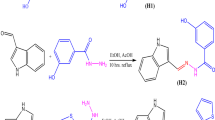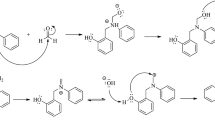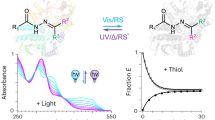Abstract
IN our search for reactive keto groups in the protein molecule, we found that 2,4-dinitrophenylhydrazine could be coupled with the protein framework to a surprisingly great extent (one molecule of the hydrazine to about six amino-acid residues). In a typical experiment, 100 gm. casein ("nach Hammarsten") was boiled with 1,000 c.c. 0·3 N hydrochloric acid and 10 gm. 2,4-dinitrophenylhydrazine. From time to time 4 c.c. samples of the mixture were removed, precipitated with 5 c.c. 10 per cent trichloroacetic acid, centrifuged, and 2 c.c. of the supernatant liquid and the whole of the precipitate dissolved in N sodium hydroxide, each to a total volume of 50 c.c. The extinction coefficients of these deep red solutions were measured in a Zeiss colorimeter (green filter, 0·5 cm. cuvette). When the hydrazine is not coupled, the red colour fades immediately. The intensity of the permanent colour is found to be proportional to the amount of hydrazine bound in a similar manner to that occurring in hydrazones1.
This is a preview of subscription content, access via your institution
Access options
Subscribe to this journal
Receive 51 print issues and online access
$199.00 per year
only $3.90 per issue
Buy this article
- Purchase on SpringerLink
- Instant access to full article PDF
Prices may be subject to local taxes which are calculated during checkout
Similar content being viewed by others
References
Sealock and Scherp, J. Biol. Chem., 140, cxiv (1941).
Author information
Authors and Affiliations
Rights and permissions
About this article
Cite this article
CHESSMAN, D., EHRENSVÄRD, G. Slow Protein Hydrolysis in the Presence of 2,4-Dinitrophenylhydrazine. Nature 153, 108–109 (1944). https://doi.org/10.1038/153108a0
Issue date:
DOI: https://doi.org/10.1038/153108a0



